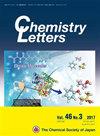通过 NaNbO3 和 BN 的偏合成反应合成 ε-NbN 和 δ-NbN
IF 1.1
4区 化学
Q3 CHEMISTRY, MULTIDISCIPLINARY
引用次数: 0
摘要
在 1373 K 下加热 NaNbO3 和 BN 粉末的混合物 1 小时,可获得颗粒大小约为 1 µm 的 δ-NbN 粉末;在相同温度下加热混合物 10 小时,可获得由大小达 50 µm 的 ε-NbN 小板粒组成的团聚体。波长色散 X 射线分析表明,合成的 δ-NbN 和 ε-NbN 中 Nb 与 N 的摩尔比约为 1:1。磁感应强度测量结果表明,δ-NbN 粉末是一种超导体,其转变温度约为 16 K。本文章由计算机程序翻译,如有差异,请以英文原文为准。
Synthesis of ε-NbN and δ-NbN by metathesis reaction of NaNbO3 and BN
δ-NbN powder with particles of approximately 1 µm in size was obtained by heating a mixture of NaNbO3 and BN powders at 1373 K for 1 h, while agglomerates composed of ε-NbN platelet grains up to 50 µm in size were obtained by heating the mixture at the same temperature for 10 h. Metathesis reaction in which sodium borate was formed with replacement of the oxygen and nitrogen from NaNbO3 and BN occurred with the NbN formation. Wavelength-dispersive X-ray analysis showed that the molar ratios of Nb to N in the synthesized δ-NbN and ε-NbN were approximately 1:1. Magnetic susceptibility measurements showed that the δ-NbN powder was a superconductor with a transition temperature of approximately 16 K. In comparison, the ε-NbN agglomerates did not exhibit superconductivity above 2 K.
求助全文
通过发布文献求助,成功后即可免费获取论文全文。
去求助
来源期刊

Chemistry Letters
化学-化学综合
CiteScore
3.00
自引率
6.20%
发文量
260
审稿时长
1.2 months
期刊介绍:
Chemistry Letters covers the following topics:
-Organic Chemistry-
Physical Chemistry-
Inorganic Chemistry-
Analytical Chemistry-
Materials Chemistry-
Polymer Chemistry-
Supramolecular Chemistry-
Organometallic Chemistry-
Coordination Chemistry-
Biomolecular Chemistry-
Natural Products and Medicinal Chemistry-
Electrochemistry
 求助内容:
求助内容: 应助结果提醒方式:
应助结果提醒方式:


